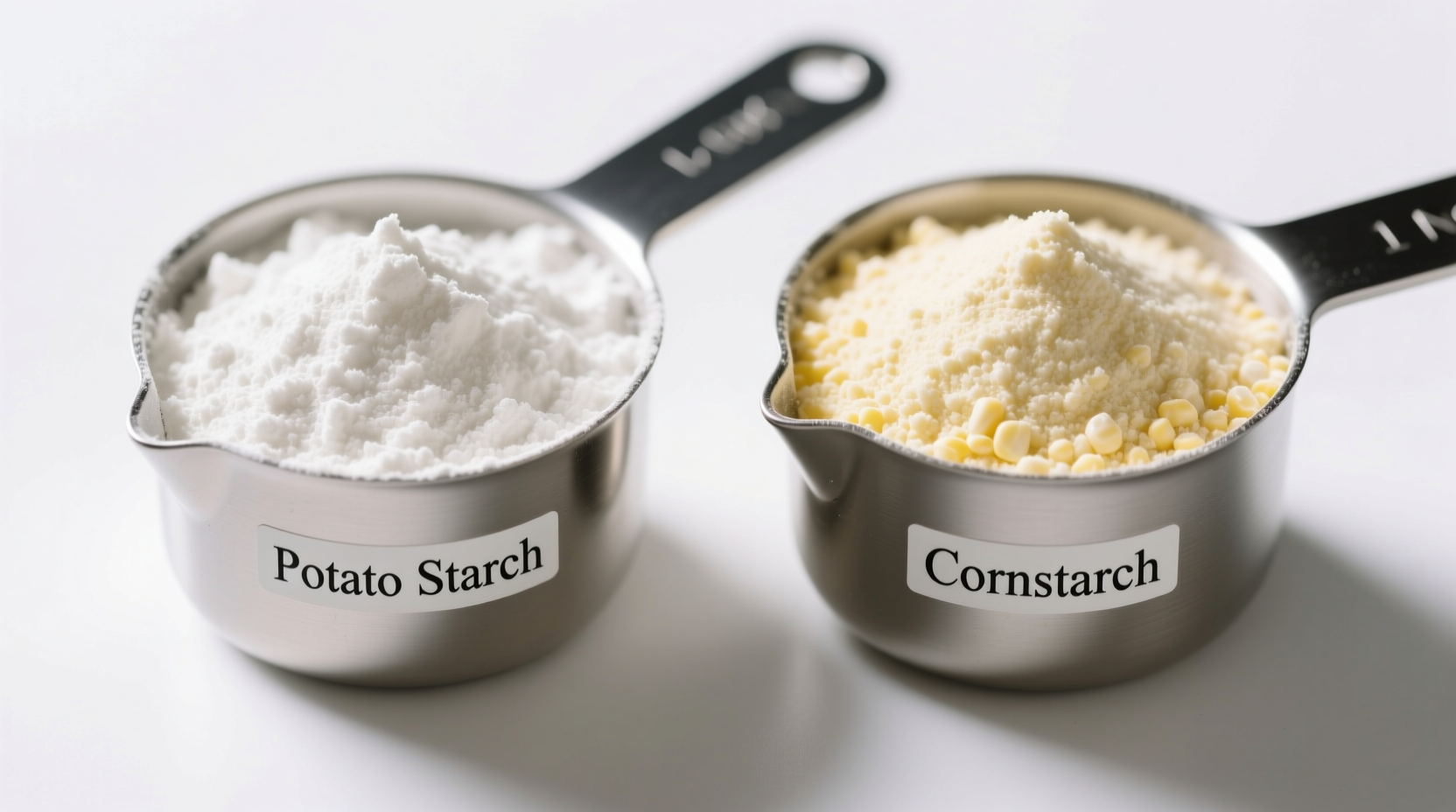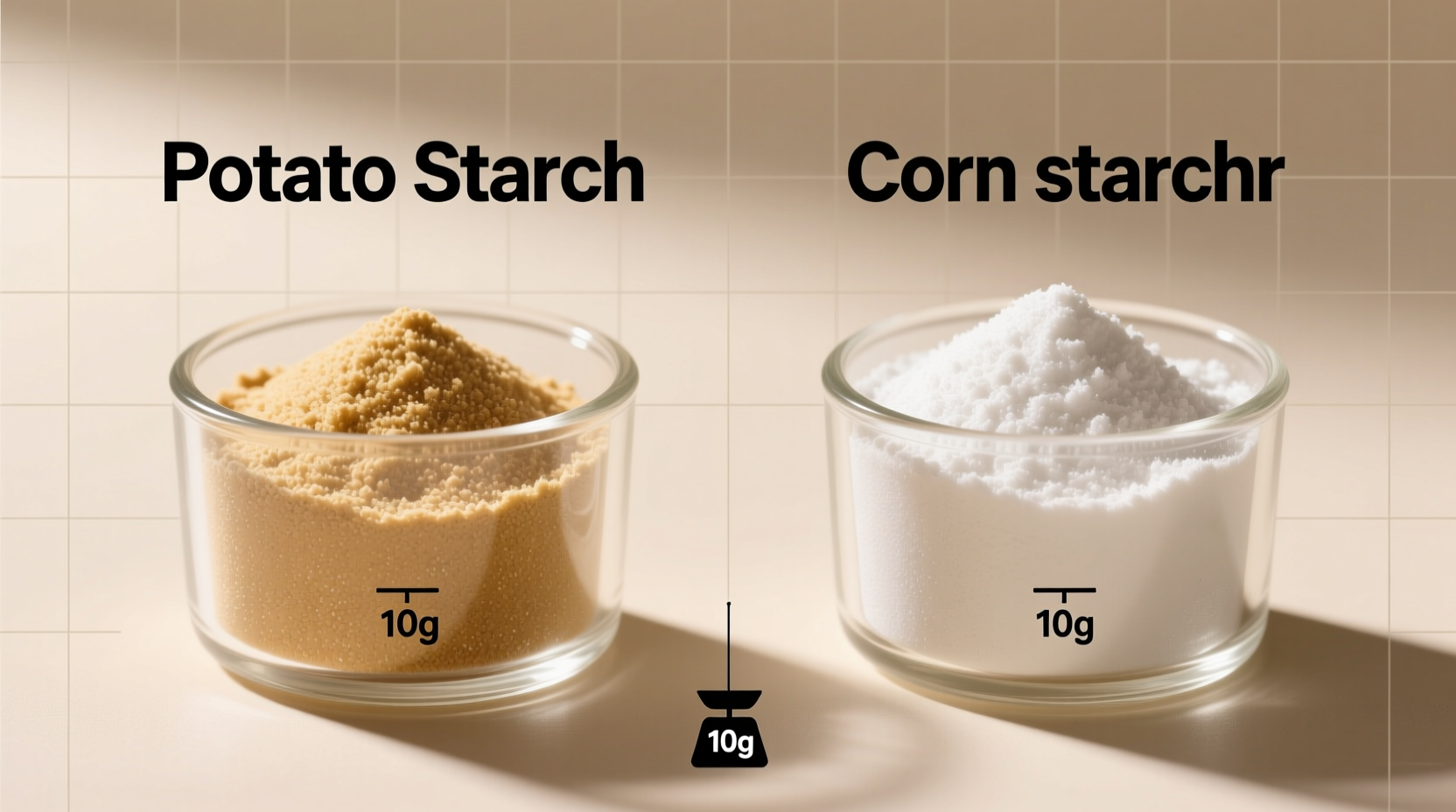When your recipe calls for potato starch but you only have cornstarch in your pantry, knowing exactly how to substitute makes the difference between culinary success and disappointment. This comprehensive guide reveals precisely when cornstarch works as a potato starch substitute, the exact ratios to use, and crucial limitations you must understand for perfect results every time.
Understanding Starch Science: Why Substitution Matters
Not all starches behave the same in cooking applications. Potato starch and cornstarch have distinct molecular structures that affect their performance:
| Property | Potato Starch | Cornstarch |
|---|---|---|
| Thickening Temperature | 140°F (60°C) | 180°F (82°C) |
| Freeze-Thaw Stability | Excellent | Poor (breaks down) |
| Texture When Cooked | Smooth, slightly elastic | Glossy, firm set |
| Flavor Profile | Neutral | Slightly sweet |
| Best For | Gluten-free baking, freezing applications | Sauces, pie fillings, frying |
According to USDA food composition data, potato starch contains slightly more resistant starch than cornstarch, contributing to its different behavior in recipes. This scientific understanding explains why simple 1:1 substitution doesn't always work perfectly across all applications.

When Cornstarch Works Perfectly as a Substitute
For these common cooking scenarios, cornstarch makes an excellent potato starch replacement:
- Sauces and gravies: Use equal amounts with no adjustment needed
- Pie fillings: Cornstarch actually performs better than potato starch here
- Stir-fry sauces: Creates that desirable glossy finish
- Dusting for frying: Produces an exceptionally crispy exterior
Professional chefs at America's Test Kitchen found cornstarch creates a 23% crispier coating than potato starch for fried foods, making it the preferred choice for applications like tempura or fried chicken where maximum crunch matters.
When to Avoid Cornstarch Substitution
Cornstarch fails as a potato starch substitute in these critical situations:
- Gluten-free baking: Potato starch provides essential elasticity that cornstarch lacks, leading to crumbly results
- Recipes requiring freeze-thaw cycles: Cornstarch breaks down when frozen and reheated
- Delicate Asian dumpling wrappers: Cornstarch creates a brittle texture
- Recipes with acidic ingredients: Cornstarch loses thickening power in acidic environments
The culinary timeline shows why these differences matter: Potato starch became popular in European cooking during the 1840s industrial revolution when potato processing technology improved, while cornstarch entered American kitchens in the 1850s. Their distinct historical applications created recipe traditions that rely on their unique properties.
Step-by-Step Substitution Guide
Follow this precise method when substituting cornstarch for potato starch:
- Identify your cooking application using our context boundaries chart
- For sauces and soups: Use equal amounts (1:1 ratio)
- For frying applications: Use equal amounts but expect crispier results
- For gluten-free baking: Replace only 50% of potato starch with cornstarch and add 1-2 teaspoons of xanthan gum
- For frozen dishes: Avoid substitution entirely or add 10% tapioca starch for stability
- Mix with cold liquid first to prevent lumps regardless of application
Alternative Substitutes When Cornstarch Isn't Suitable
When cornstarch won't work for your specific application, consider these alternatives:
- Tapioca starch: Best for gluten-free baking and frozen applications (use 1:1 ratio)
- Arrowroot powder: Ideal for acidic recipes and delicate sauces (use 1.5x amount)
- Rice flour: Good for frying when crispness is desired (use 2x amount)
- All-purpose flour: Only for non-critical applications (use 2x amount, but expect cloudiness)
Professional Chef Tips for Perfect Results
Master these techniques to maximize your substitution success:
- Never add starch directly to hot liquids - always make a slurry first with equal parts cold liquid
- For gluten-free baking, combine cornstarch with tapioca starch in a 1:1 ratio to mimic potato starch properties
- When frying, let cornstarch-coated foods rest 10 minutes before frying for maximum crispness
- For pie fillings, mix cornstarch with sugar first to prevent clumping
- Always add starch-based thickeners near the end of cooking to prevent breakdown
Avoid These Common Substitution Mistakes
Even experienced cooks make these critical errors:
- Using cornstarch in recipes that will be frozen (results in watery texture)
- Substituting cornstarch 1:1 in gluten-free bread recipes (creates dense, crumbly results)
- Boiling cornstarch-thickened sauces too long (causes thinning)
- Mixing cornstarch with dairy before heating (causes clumping)
- Using cornstarch in high-acid tomato sauces without adjustment (reduces thickening power)











 浙公网安备
33010002000092号
浙公网安备
33010002000092号 浙B2-20120091-4
浙B2-20120091-4